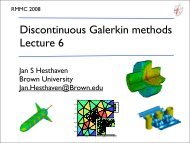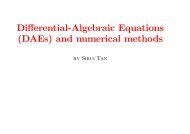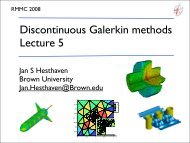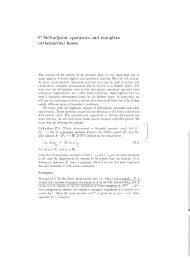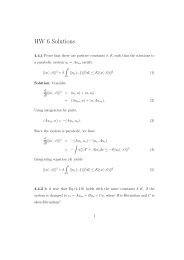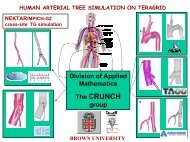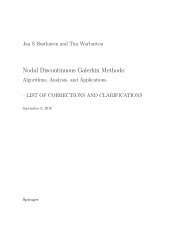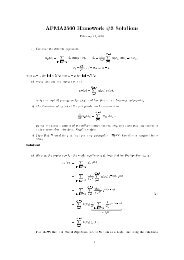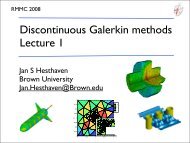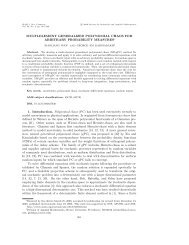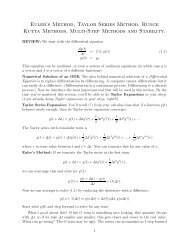Discontinuous Galerkin methods Lecture 3 - Brown University
Discontinuous Galerkin methods Lecture 3 - Brown University
Discontinuous Galerkin methods Lecture 3 - Brown University
Create successful ePaper yourself
Turn your PDF publications into a flip-book with our unique Google optimized e-Paper software.
The above estimates is based on areN all + n=0 related 1 points. to The projections. difference However, mayn=0 beasminor, we disbut<br />
it is essential to<br />
cussedisinbased Chapter appreciate on N 3, + we1 are points. it. Consider oftenThe concerned difference withmay the be interpolations minor, butofitvis essential to<br />
where<br />
Approximation theory<br />
4.3 Approximations by orthogonal polynomials a<br />
v = V ˆv,<br />
The above estimates are all related to projections.<br />
We consider cussed in Chapter 3, we are often concerned with th<br />
where N<br />
vh(r) = ˆvn v = V ˆv,<br />
˜ N<br />
Pn(r), ˜vh(r) = ˜vn ˜ appreciate it. Consider<br />
N<br />
vh(r) = ˆvn<br />
n=0<br />
Pn(r),<br />
˜ N<br />
Pn(r), ˜vh(r) = ˜vn<br />
n=0<br />
˜ N<br />
vh(r) = ˆvn<br />
n=0<br />
Pn(r),<br />
where vh(x) is the usual approximation based on interpolation and ˜vh(r) refers<br />
˜ N<br />
Pn(r), ˜vh(r) = ˜vn<br />
n=0<br />
˜ ere vh(x) is the usual approximation based on interpolation and ˜vh(r) ref<br />
the approximation based on projection.<br />
Pn(r),<br />
By the interpolation property we have<br />
where vh(x) is the usual approximation based on interpolation and ˜vh(r) refers<br />
∞<br />
to the approximation based on projection.<br />
(V ˆv)i = vh(ri) = ˜vn ˜ N<br />
Pn(ri) = ˜vn ˜ ∞<br />
Pn(ri)+ ˜vn ˜ interpolation projection<br />
Pn(ri),<br />
is based on N + 1 points. The difference may be minor, but it is essential to<br />
appreciate it. Consider<br />
to the approximation By the interpolation based on projection. property we have<br />
n=0<br />
n=0<br />
By the interpolation is based property on N ∞ + we1 have points. The difference may be minor,<br />
appreciate (V ˆv)i = vh(ri)<br />
∞ it. = ˜vn Consider N<br />
∞<br />
˜ N<br />
Pn(ri) = ˜vn ˜ ∞<br />
Pn(ri)+ ˜vn ˜ n=0<br />
n=0<br />
n=N+1<br />
Compare the two<br />
Pn(ri),<br />
m which we recover<br />
where vh(x) is the usual approximation based on interpolation and ˜vh(r) refers<br />
to the approximation based on projection.<br />
By the interpolation property we haven=0<br />
n=0<br />
N<br />
vh(r) = ˆvn ˜ ∞<br />
˜vn Pn(r), ˜vh(r) =<br />
˜ n=0<br />
n=N+1<br />
˜vn Pn(ri),<br />
˜ Pn(r), r =(r0,...,rN ) T .<br />
∞<br />
(V ˆv)i = vh(ri) = ˜vn<br />
n=0<br />
n=0<br />
˜ N<br />
Pn(ri) = ˜vn<br />
n=0<br />
˜ from which we recover n=0<br />
Pn(ri)+<br />
from which we recover<br />
∞<br />
n=N+1<br />
V ˆv = V ˜v + ˜vn<br />
∞<br />
from which we recover<br />
n=N+1<br />
˜ Pn(r), r =(r0,...,rN ) T V ˆv = V ˜v +<br />
n=N+1<br />
.<br />
is implies<br />
This implies<br />
This implies<br />
(V ˆv)i = vh(ri) =<br />
V ˆv = V ˜v +<br />
˜vn ˜ Pn(ri) =<br />
∞<br />
N<br />
n=0<br />
˜vn ˜ Pn<br />
where∞ vh(x) is the usual approximation based on interpol<br />
˜vn to the approximation based on projection.<br />
n=N+1<br />
By the interpolation property we have<br />
˜ Pn(r), r =(r0,...,rN ) T n=N+1<br />
.<br />
vh(r) = ˜vh(r)+ ˜ P T (r)V −1<br />
∞<br />
˜vn ˜ ∞<br />
˜vn Pn(r). ˜ Pn(r).<br />
This implies<br />
V ˆv = V ˜v +<br />
vh(r) = ˜vh(r)+ ˜ P T (r)V −1<br />
vh(r) = ˜vh(r)+ ∞<br />
˜ P T (r)V −1<br />
˜vn ˜ n=N+1<br />
Now, consider the additional term on the right-hand<br />
Pn(r).<br />
side,<br />
∞<br />
(V ˆv)i = vh(ri) = ˜vn ˜ N<br />
Pn(ri) = ˜vn ˜ vh(r) = ˜vh(r)+<br />
Pn(ri)+<br />
˜ P T (r)V −1<br />
˜vn<br />
n=N+1<br />
˜ Pn(r). n=N+1<br />
Now, consider the˜P additional term on the right-hand side,<br />
T (r)V −1<br />
∞<br />
˜vn ˜ w, consider the additional term on the right-hand side,<br />
∞ <br />
T<br />
Pn(r) = ˜vn<br />
˜P −1<br />
(r)V Pn(r) ˜<br />
∞ ∞<br />
,<br />
<br />
Now, consider the additional term on the right-hand side,<br />
˜vn ˜ Pn(ri)+<br />
˜vn ˜ Pn(r), r =(r0,...,rN ) T .<br />
∞<br />
n=N+1<br />
n=N+1<br />
˜vn ˜ Pn(ri),



